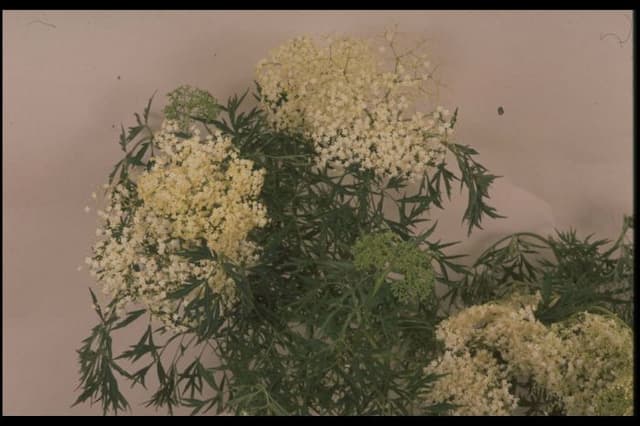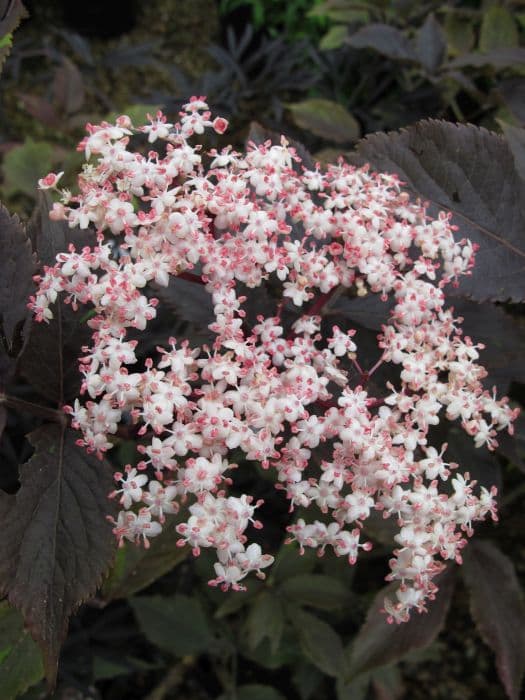Japanese Snowball Viburnum plicatum f. plicatum Newport = 'Newzam'

ABOUT
Viburnum plicatum, commonly known as doublefile viburnum, is a visually striking plant revered for its distinctive layered branches which give it a tiered appearance. This ornamental shrub showcases horizontal branching patterns, and in spring, it becomes even more spectacular when adorned with lacecap-style flowers. The blooms are characterized by small, fertile flowers at the center surrounded by larger, showier, sterile flowers that create a prominent, white, snowball-like effect. The flower clusters are elegantly arranged across the branches, creating rows of blossoms that highlight the plant's symmetrical form. After flowering, the plant produces red berries that mature to black, offering visual interest and attracting wildlife like birds. The leaves of doublefile viburnum are another beautiful aspect, with a distinct pleated or puckered texture—hence the name "plicatum." These leaves are dark green and have a slightly glossy appearance. As the seasons change, the foliage transitions to a splendid display of red to purple hues, providing a stunning autumnal show. While the plant stands out for its floral and foliar attributes, it is also noted for the overall elegance it brings to garden settings. Its presence is often used as a focal point in landscapes, where it can be appreciated for its refined beauty and the strong structural statement it makes throughout the year.
About this plant
 Names
NamesFamily
Adoxaceae
Synonyms
Japanese Snowball, Doublefile Viburnum, Newport Viburnum
Common names
Viburnum plicatum f. tomentosum 'Newzam'
 Toxicity
ToxicityTo humans
The Japanese Snowball, which is a common name for Viburnum plicatum (including the variety 'Newzam'), is generally considered non-toxic to humans. Ingestion of any part of this plant typically does not lead to poisoning or the development of severe symptoms. However, it is always advisable to exercise caution and avoid ingesting plant material that is not meant for human consumption, as individual sensitivity can vary and potential for mild stomach upset or other minor symptoms may exist.
To pets
The Japanese Snowball, which is a common name for Viburnum plicatum (including the variety 'Newzam'), is generally not considered toxic to pets. It is not known to cause serious illness or poisoning in cats, dogs, or other domestic animals if they ingest parts of this plant. However, ingestion of large amounts of plant material can sometimes lead to mild gastrointestinal upset, such as vomiting or diarrhea, due to the non-digestible nature of the plant matter rather than specific toxicity. It is still best to keep an eye on pets and prevent them from consuming plants unnecessarily.
 Characteristics
CharacteristicsLife cycle
Perennials
Foliage type
Deciduous
Color of leaves
Green
Flower color
White
Height
5-6 feet [1.5-1.8 meters]
Spread
4-5 feet [1.2-1.5 meters]
Plant type
Shrub
Hardiness zones
5
Native area
Asia
Benefits
 General Benefits
General Benefits- Decorative Appeal: Its elegant tiered branches and lace-cap white flowers add aesthetic value to any landscape.
- Seasonal Interest: This plant offers year-round interest with its flowers in spring, berries in summer, and colorful foliage in fall.
- Wildlife Attraction: Its berries provide food for birds, while flowers may attract beneficial pollinators.
- Low Maintenance: The Newport variety is known for being easy to care for, requiring minimal maintenance once established.
- Durable: It is generally resistant to common pests and diseases, making it a robust addition to gardens.
- Versatility: It can be used in various landscape applications, including hedges, borders, or as a specimen plant.
- Privacy Screen: With its dense growth habit, it can serve as an effective privacy screen or windbreak.
 Medical Properties
Medical PropertiesThis plant is not used for medical purposes.
 Air-purifying Qualities
Air-purifying QualitiesThis plant is not specifically known for air purifying qualities.
 Other Uses
Other Uses- Wildlife Habitat: The dense branching structure of Doublefile Viburnum provides excellent cover and nesting sites for birds.
- Hedging: Its uniform growth habit makes it suitable for forming tidy and visually appealing hedges in gardens and parks.
- Screening: Doublefile Viburnum can be planted in rows to create a natural screen that offers privacy throughout the year.
- Topiary: With regular pruning, this viburnum can be trained into various topiary shapes to decorate formal gardens.
- Erosion Control: The plant's robust root system helps stabilize slopes and areas prone to erosion.
- Bonsai: Enthusiasts may use Doublefile Viburnum for bonsai due to its attractive flowers and foliage as well as its ability to be trained and pruned.
- Photography: Its picturesque flowers make Doublefile Viburnum an excellent subject for garden and macro photography.
- Winter Texture: The branching pattern and fruit of the viburnum add textural interest to winter gardens when many plants are dormant.
- Culinary: Some Viburnum species' fruit is edible and can make interesting additions to jellies or jams, although caution is advised as not all species or individual cultivars produce edible fruit.
- Plant Propagation: Gardeners may use cuttings from Doublefile Viburnum to propagate new plants and share with fellow horticulturists.
Interesting Facts
 Feng Shui
Feng ShuiThe Japanese Snowball is not used in Feng Shui practice.
 Zodiac Sign Compitability
Zodiac Sign CompitabilityThe Japanese Snowball is not used in astrology practice.
 Plant Symbolism
Plant Symbolism- Renewal: The Viburnum plicatum, commonly known as Japanese Snowball, often symbolizes renewal because it blooms in spring, a season associated with new beginnings.
- Beauty and Grace: With its elegant and snowball-like blooms, this plant is often representative of beauty and grace in the plant world.
- Perseverance: The hardiness of this shrub, which allows it to thrive in various conditions, makes it a symbol of perseverance and resilience.
- Abundance: The plentiful and clustered flowers of the Japanese Snowball can be symbolic of abundance or wealth.
 Water
WaterNewport Viburnum requires consistent moisture for optimal growth, particularly during its first few growing seasons. It's best to water this plant deeply once a week, providing it with about 1-2 inches of water each time; this would be approximately 0.62-1.25 gallons for a small shrub. During hot or dry weather, you may need to water twice weekly to maintain the soil's moisture, but always check the soil beforehand to ensure it is not already saturated. Reducing watering frequency to every two to three weeks is usually sufficient during the cooler months. Make sure to water at the base of the plant to keep the foliage dry and prevent any potential disease spread.
 Light
LightNewport Viburnum thrives in locations that receive full to partial sunlight, ideally around six to eight hours of direct sun per day. It can tolerate some shade, particularly in the hotter afternoon hours, so planting it where it can get morning sun and afternoon shade is beneficial. Avoid deep shade areas, as insufficient light can lead to poor flowering and weak growth.
 Temperature
TemperatureNewport Viburnum is hardy and can tolerate a range of temperatures. It prefers to grow in zones 5 to 8, with the ideal growing temperatures ranging between 60°F and 75°F. It can survive minimum winter temperatures down to -20°F once well-established. To maintain healthy growth, try to avoid exposure to extreme heat above 95°F for prolonged periods.
 Pruning
PruningNewport Viburnum benefits from annual pruning to maintain its shape, improve airflow, and encourage more vigorous growth and better flowering. The best time to prune this viburnum is immediately after it finishes flowering in late spring to early summer. During pruning, remove any dead or damaged branches and thin out older stems to rejuvenate the plant. Depending on the desired shape, light shaping or more formal pruning can be performed at this time.
 Cleaning
CleaningAs needed
 Soil
SoilJapanese Snowball 'Newzam' prefers well-draining soil with a rich organic content; a mix of loam, peat moss, and perlite would be ideal. The soil pH should be slightly acidic to neutral, ranging between 5.6 and 7.5.
 Repotting
RepottingJapanese Snowball 'Newzam' does not commonly need repotting as it is typically grown as a landscape shrub; however, if planted in a container, it should be repotted every 3-5 years to replenish the soil and provide room for growth.
 Humidity & Misting
Humidity & MistingJapanese Snowball 'Newzam' thrives in average outdoor humidity levels; it does not have specific humidity requirements, making it adaptable to various outdoor conditions.
 Suitable locations
Suitable locationsIndoor
Place in bright, indirect light and rotate periodically.
Outdoor
Plant in partial shade, ensure moist, well-drained soil.
Hardiness zone
5-8 USDA
 Life cycle
Life cycleThe life cycle of the Viburnum plicatum f. plicatum 'Newport', also known as Japanese Snowball, begins with seed germination, where environmental conditions such as temperature and moisture trigger the emergence of a new plant from a seed. The seedling stage follows, characterized by the growth of roots, a stem, and embryonic leaves, which will develop into true leaves capable of photosynthesis. As the plant enters the vegetative stage, it focuses on growth, developing a robust root system and a fuller canopy through a process of branching and leaf production. The plant reaches maturity in the reproductive stage, where it produces characteristic white, globe-shaped flowers clustered in snowball-like formations, which are pollinated by insects and potentially capable of setting fruit in the form of small red-to-black berries if cross-pollinated. After pollination and fruit set, the plant enters a period of senescence yearly, where older leaves and potentially some branches die back, usually coinciding with colder weather. However, as a perennial, the plant will return from dormancy in the following growing season, repeating the cycle of growth, flowering, and senescence for many years.
 Propogation
PropogationPropogation time
Early Spring
The most popular method for propagating the Viburnum plicatum f. plicatum 'Newport', also known as the Newport Flowering Viburnum, is through softwood cuttings. This technique is best carried out in late spring or early summer when new growth is still flexible but also mature enough to survive on its own. To propagate by softwood cuttings, one takes a cutting about 4 to 6 inches (approximately 10 to 15 cm) long from a healthy branch, ensuring there are several leaf nodes present. The cutting's lower leaves should be removed, and the cut end dipped in rooting hormone powder to encourage root development. Afterward, the cutting is planted in a well-draining potting mix and kept in a humid environment with indirect sunlight until roots have formed, which usually takes several weeks. Regular misting during this time helps prevent the cutting from drying out. Once the new plant has established a sufficient root system, it can be transplanted to its final location.









